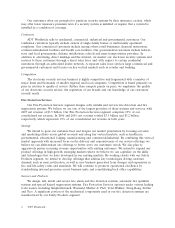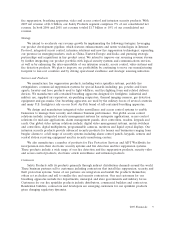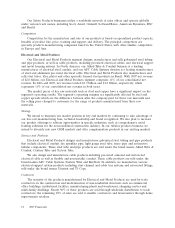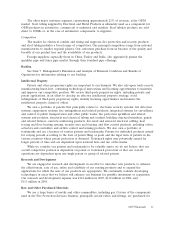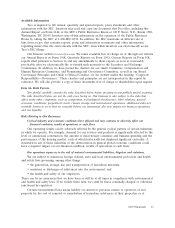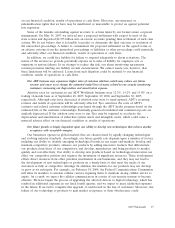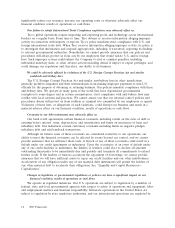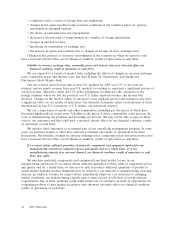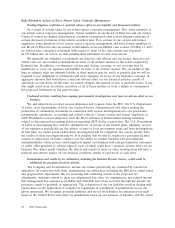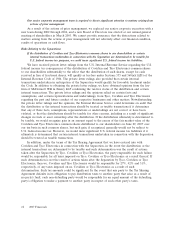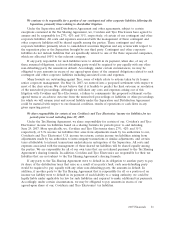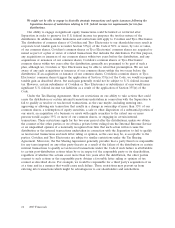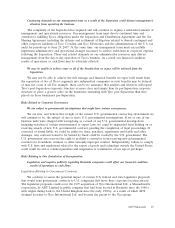ADT 2007 Annual Report Download - page 107
Download and view the complete annual report
Please find page 107 of the 2007 ADT annual report below. You can navigate through the pages in the report by either clicking on the pages listed below, or by using the keyword search tool below to find specific information within the annual report.on our financial condition, results of operations or cash flows. Moreover, any insurance or
indemnification rights that we have may be insufficient or unavailable to protect us against potential
loss exposures.
Some of the lawsuits outstanding against us relate to actions taken by our former senior corporate
management. On May 14, 2007, we entered into a proposed settlement with respect to most of the
class actions and deposited $2.975 billion into an escrow accounts pending final settlement of such class
actions. We do not believe that it is feasible to predict or determine the final outcome or resolution of
the unresolved proceedings. A failure to consummate the proposed settlement on the agreed terms or
an adverse outcome from the unresolved proceedings or liabilities or other proceedings could materially
and adversely affect our financial condition, results of operations or cash flows.
In addition, we could face liability for failure to respond adequately to alarm activations. The
nature of the services we provide potentially exposes us to risks of liability for employee acts or
omissions or system failures. In an attempt to reduce this risk, our alarm monitoring agreements
contain provisions limiting our liability in such circumstances. We cannot assure you, however, that
these limitations will be enforced. Losses from such litigation could be material to our financial
condition, results of operations or cash flows.
Our ADT business may experience higher rates of customer attrition, which may reduce our future
revenue and cause us to change the estimated useful lives of assets related to our security monitoring
customers, increasing our depreciation and amortization expense.
Attrition rates for customers in our ADT Worldwide business were 12.3%, 14.2% and 15.0% on a
trailing 12-month basis as of September 28, 2007, September 29, 2006 and September 30, 2005,
respectively. Although rates have decreased, if attrition rates were to trend upward, ADT’s recurring
revenue and results of operations will be adversely affected. Tyco amortizes the costs of ADT’s
contracts and related customer relationships purchased through the ADT dealer program based on the
estimated life of the customer relationships. Internally generated residential and commercial pools are
similarly depreciated. If the attrition rates were to rise Tyco may be required to accelerate the
depreciation and amortization of subscriber system assets and intangible assets, which could cause a
material adverse effect on our financial condition or results of operations.
Our future growth is largely dependent upon our ability to develop new technologies that achieve market
acceptance with acceptable margins.
Our businesses operate in global markets that are characterized by rapidly changing technologies
and evolving industry standards. Accordingly, our future growth rate depends upon a number of factors,
including our ability to: identify emerging technological trends in our target end-markets; develop and
maintain competitive products; enhance our products by adding innovative features that differentiate
our products from those of our competitors; and develop, manufacture and bring products to market
quickly and cost-effectively. Our ability to develop new products based on technological innovation can
affect our competitive position and requires the investment of significant resources. These development
efforts divert resources from other potential investments in our businesses, and they may not lead to
the development of new technologies or products on a timely basis or that meet the needs of our
customers as fully as competitive offerings. In addition, the markets for our products may not develop
or grow as we anticipate. For example, on February 18, 2008, the Federal Communications Commission
will allow its mandate to wireless cellular carriers requiring them to maintain analog cellular service to
expire. As a result, we expect the cellular communicators in certain of our security systems to become
obsolete. We have begun the process of upgrading the affected devices to digital technology, which has
resulted in additional expenses in our fiscal fourth quarter, and we expect to incur additional expenses
in the future. If we fail to complete this upgrade, it could result in the loss of customers. Moreover, the
failure of our technology or products to gain market acceptance or their obsolescence could
2007 Financials 15



